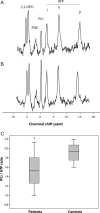Concentric hypertrophic remodelling and subendocardial dysfunction in mitochondrial DNA point mutation carriers
- PMID: 23129433
- PMCID: PMC3681541
- DOI: 10.1093/ehjci/jes226
Concentric hypertrophic remodelling and subendocardial dysfunction in mitochondrial DNA point mutation carriers
Abstract
Aims: Hypertrophic remodelling and systolic dysfunction are common in patients with mitochondrial disease and independent predictors of morbidity and early mortality. Screening strategies for cardiac disease are unclear. We investigated whether myocardial abnormalities could be identified in mitochondrial DNA mutation carriers without clinical cardiac involvement.
Methods and results: Cardiac magnetic resonance imaging was performed in 22 adult patients with mitochondrial disease due to the m.3243A>G mutation, but no known cardiac involvement, and 22 age- and gender-matched control subjects: (i) Phosphorus-31- magnetic resonance spectroscopy, (ii) cine imaging (iii), cardiac tagging and (iv) late gadolinium enhancement (LGE) imaging. Disease burden was determined using the Newcastle Mitochondrial Disease Adult Scale (NMDAS) and urinary mutation load. Compared with control subjects, patients had an increased left ventricular mass index (LVMI), LV mass to end-diastolic volume (M/V) ratio, wall thicknesses (all P < 0.01), torsion and torsion to endocardial strain ratio (both P < 0.05). Longitudinal shortening was decreased in patients (P < 0.0001) and correlated with an increased LVMI (r = -0.52, P < 0.03), but there were no differences in the diastolic function. Among patients there was no correlation of LVMI or the M/V ratio with diabetic or hypertensive status, but the mutation load and NMDAS correlated with the LVMI (r = 0.71 and r = 0.79, respectively, both P < 0.001). The phosphocreatine/adenosine triphosphate ratio was decreased in patients (P < 0.001) but did not correlate with other parameters. No patients displayed focal LGE.
Conclusion: Concentric remodelling and subendocardial dysfunction occur in patients carrying m.3243A>G mutation without clinical cardiac disease. Patients with higher mutation loads and disease burden may be at increased risk of cardiac involvement.
Keywords: Cardiac tagging; Cardiomyopathy; Magnetic resonance imaging; Magnetic resonance spectroscopy; Mitochondrial disease.
Figures



References
-
- Hirano M, Pavlakis SG. Mitochondrial myopathy, encephalopathy, lactic acidosis, and strokelike episodes (MELAS): current concepts. J Child Neurol. 1994;9:4–13. - PubMed
-
- Anan R, Nakagawa M, Miyata M, Higuchi I, Nakao S, Suehara M, et al. Cardiac involvement in mitochondrial diseases. A study on 17 patients with documented mitochondrial DNA defects. Circulation. 1995;91:955–61. - PubMed
-
- Holmgren D, Wahlander H, Eriksson B, Oldfors A, Holme E, Tulinius M. Cardiomyopathy in children with mitochondrial disease; clinical course and cardiological findings. Eur Heart J. 2003;24:280–8. - PubMed
Publication types
MeSH terms
Substances
Grants and funding
- G1100160/MRC_/Medical Research Council/United Kingdom
- 096919/WT_/Wellcome Trust/United Kingdom
- 074454/Z/04/Z/WT_/Wellcome Trust/United Kingdom
- RG/08/012/25941/BHF_/British Heart Foundation/United Kingdom
- BH092142/WT_/Wellcome Trust/United Kingdom
- MR/K000608/1/MRC_/Medical Research Council/United Kingdom
- G0601943/MRC_/Medical Research Council/United Kingdom
- CH/07/001/BHF_/British Heart Foundation/United Kingdom
- SRF-2011-04-017/DH_/Department of Health/United Kingdom
- G0700718/MRC_/Medical Research Council/United Kingdom
- G0800674/MRC_/Medical Research Council/United Kingdom
LinkOut - more resources
Full Text Sources
Medical

